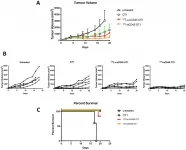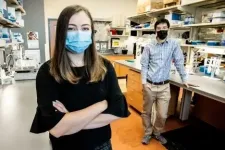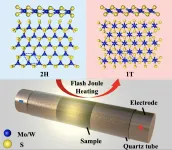(Press-News.org) PHILADELPHIA -- (Jan. 11, 2020) -- Mutations that inactivate the ARID1A gene in ovarian cancer increase utilization of the glutamine amino acid making cancer cells dependent on glutamine metabolism, according to a study by The Wistar Institute published online in Nature Cancer. Researchers also showed that pharmacologic inhibition of glutamine metabolism may represent an effective therapeutic strategy for ARID1A-mutant ovarian cancer.
Up to 60% of ovarian clear cell carcinomas (OCCC) have inactivating mutations in the ARID1A tumor suppressor gene. These mutations are known genetic drivers of this type of cancer, which typically does not respond to chemotherapy and carries the worst prognosis among all subtypes of ovarian cancer.
The laboratory of Rugang Zhang, Ph.D., deputy director of The Wistar Institute Cancer Center, professor and leader of the Immunology, Microenvironment & Metastasis Program, studies the effects of ARID1A inactivation to devise new mechanism-guided therapeutic strategies and combination approaches to enhance immunotherapy for ovarian cancer.
"Metabolic reprogramming is a hallmark of many cancers, including OCCC, so in this study we assessed whether ARID1A plays a role in regulation of metabolism," said Zhang, corresponding author on the paper. "We found that its inactivation in cancer cells creates a specific metabolic requirement for glutamine and exposed this as a vulnerability that could be exploited for therapeutic purposes."
The authors inactivated ARID1A in wild type ovarian cancer cells and observed increased glutamine consumption. Glutamine is normally required for cancer cells to grow, but Zhang and colleagues unveiled a stronger dependence of ARID1A-mutant cells on this amino acid, which significantly enhanced the growth suppression induced by glutamine deprivation.
ARID1A is part of a protein complex called SWI/SNF that modulates gene expression. The authors investigated the transcriptional effect of ARID1A inactivation and found that GLS1, which encodes for the glutaminase enzyme, was the top upregulated gene among those controlling glutamine metabolism. Accordingly, GLS1 was expressed at significantly higher levels in tumor samples from patients with other cancer types that also carry mutations in the SWI/SNF complex.
The team evaluated the therapeutic potential of inhibiting the glutamine metabolism by blocking the glutaminase enzyme with the CB-839 inhibitor. It has been reported that this molecule is under investigation in clinical trials and is well tolerated as a single agent and in combination with other anticancer therapies.
When tested in vivo on OCCC mouse models, CB-839 significantly reduced tumor burden and prolonged survival. These studies were expanded to mice carrying patient-derived tumor transplants, confirming that CB-839 impaired the growth of ARID1A-mutant but not ARID1A-wildtype tumors.
Researchers also combined CB-839 with anti-PDL1 treatment and revealed a synergy between glutaminase inhibitors and immune checkpoint blockade in suppressing the growth of ARID1A-mutant OCCC tumors.
"Our findings suggest that glutaminase inhibitors warrant further studies as a standalone or combinatorial therapeutic intervention for OCCC, for which effective options are very limited," said Shuai Wu, Ph.D., first author of the study and a staff scientist in the Zhang Lab.
Glutaminase inhibitors could become a new strategy to precisely target a specific vulnerability of OCCC cells associated with loss of ARID1A function.
INFORMATION:
Co-authors: Takeshi Fukumoto, Jianhuang Lin, Timothy Nacarelli, Heng Liu, Nail Fatkhutdinov, Joseph A. Zundell, Sergey Karakashev, Wei Zhou, Hsin-Yao Tang, Qin Liu, Andrew V. Kossenkov, David W. Speicher, Zachary T. Schug, and Chi Van Dang from The Wistar Institute; Yemin Wang, Dionzie Ong and David G. Huntsman from University of British Columbia, Vancouver, British Columbia, Canada; and Lauren E. Schwartz and Ronny Drapkin from University of Pennsylvania.
Work supported by: National Institutes of Health (NIH) grants R01CA160331, R01CA163377, R01CA202919, R01CA239128, P01AG031862, P50CA228991, K99CA241395, R50CA221838, S10OD023658, S10OD023586; R01CA195670, F31CA247336, and T32CA009191; U.S. Department of Defense grants OC180109 and OC190181. Additional support was provided by The Honorable Tina Brozman Foundation for Ovarian Cancer Research and The Tina Brozman Ovarian Cancer Research Consortium 2.0; and the Ovarian Cancer Research Alliance (Collaborative Research Development Grant #596552 and Ann and Sol Schreiber Mentored Investigator Award #598026). Core support for The Wistar Institute was provided by the Cancer Center Support Grant P30CA010815.
Publication information: Targeting glutamine dependence through GLS1 inhibition suppresses ARID1A-inactivated clear cell ovarian carcinoma, Nature Cancer, 2020. Online publication.
The Wistar Institute is an international leader in biomedical research with special expertise in cancer research and vaccine development. Founded in 1892 as the first independent nonprofit biomedical research institute in the United States, Wistar has held the prestigious Cancer Center designation from the National Cancer Institute since 1972. The Institute works actively to ensure that research advances move from the laboratory to the clinic as quickly as possible. wistar.org.
Oncotarget recently published "Targeted lymphodepletion with a CD45-directed antibody radioconjugate as a novel conditioning regimen prior to adoptive cell therapy" which reported that Chimeric antigen receptor T cell therapies, and adoptive cell therapy in general, represent one of the most promising anti-cancer strategies.
In contrast to relatively non-specific chemotherapy-derived lymphodepletion, targeted lymphodepletion with radioimmunotherapy directed to CD45 may be a safer and more effective alternative to target and deplete immune cells. Here the authors describe the results ...
For the brain to learn, retain memories, process sensory information, and coordinate body movements, its groups of nerve cells must generate coordinated electrical signals. Disorder in synchronous firing can impair these processes and, in extreme cases, lead to seizures and epilepsy.
Synchrony between neighboring neurons depends on the protein connexin 36, an essential element of certain types of synaptic connections that, unlike classical chemical synapses, pass signals between neurons through direct electrical connections. For more than 15 years, scientists have debated the tie between connexin 36 and epilepsy.
Now, a team of Virginia Tech scientists led by Yuchin Albert Pan, an associate professor at the Fralin Biomedical Research ...
Many policymakers and educational institutions hope to boost their economies by stimulating students' entrepreneurial intentions. To date, most research concluded that entrepreneurship education could increase these intentions by improving the image that students have of entrepreneurship as a career option, making them see how their environment can help them become entrepreneurs or increasing their self-confidence regarding their entrepreneurial skills. However, recent studies show that even if these goals are achieved, students' entrepreneurial intentions often ...
HOUSTON - (Jan. 11, 2021) - Rice University scientists have extended their technique to produce graphene in a flash to tailor the properties of other 2D materials.
The labs of chemist James Tour and materials theorist Boris Yakobson reported in the American Chemical Society's ACS Nano they have successfully "flashed" bulk amounts of 2D dichalcogenides, changing them from semiconductors to metallics.
Such materials are valuable for electronics, catalysis and as lubricants, among other applications.
The process employs flash Joule heating -- using an electrical charge to dramatically raise the material's temperature -- to convert semiconducting molybdenum disulfide and tungsten disulfide. The duration of the pulse and select additives can also control the now-metallic products' ...
DURHAM, N.C. - A Duke-led team of scientists has developed a bio-compatible surgical patch that releases non-opioid painkillers directly to the site of a wound for days and then dissolves away.
The polymer patch provides a controlled release of a drug that blocks the enzyme COX-2 (cyclooxygenase-2,) which drives pain and inflammation. The study appears Jan. 10, 2021 in the Journal of Controlled Release.
When they started "We were making hernia meshes and different antimicrobial films," said Matthew Becker, the Hugo L. Blomquist professor chemistry at Duke, and last author on the paper. "We thought you could potentially put pain drugs or anesthetics in the film if you ...
A shapeshifting immune system protein called XCL1 evolved from a single-shape ancestor hundreds of millions of years ago. Now, researchers at the Medical College of Wisconsin (MCW) discovered the molecular basis for how this happened. In the process they uncovered principles that scientists can use to design purpose-built nanoscale transformers for use as biosensors, components of molecular machines, and even therapeutics. The findings were published today in Science. The primary and senior authors of the manuscript, respectively, are MCW researchers Acacia Dishman, MD-PhD student, and Brian Volkman, PhD, professor of biochemistry.
Molecular switches can be used to detect cancer, construct nanoscale machines, and even build cellular computers. ...
Scientists crafting a nickel-based catalyst used in making hydrogen fuel built it one atomic layer at a time to gain full control over its chemical properties. But the finished material didn't behave as they expected: As one version of the catalyst went about its work, the top-most layer of atoms rearranged to form a new pattern, as if the square tiles that cover a floor had suddenly changed to hexagons.
But that's ok, they reported today, because understanding and controlling this surprising transformation gives them a new way to turn catalytic activity on and off and make good catalysts ...
Women who use marijuana could have a more difficult time conceiving a child than women who do not use marijuana, suggests a study by researchers at the National Institutes of Health. Marijuana use among the women's partners--which could have influenced conception rates--was not studied. The researchers were led by Sunni L. Mumford, Ph.D., of the Epidemiology Branch in NIH's Eunice Kennedy Shriver National Institute of Child Health and Human Development. The study appears in Human Reproduction.
The women were part of a larger group trying to conceive after one or two prior miscarriages. Women who said they used cannabis products--marijuana or hashish--in the weeks before pregnancy, or who had positive urine tests for cannabis ...
Scientists have used a "galaxy-sized" space observatory to find possible hints of a unique signal from gravitational waves, or the powerful ripples that course through the universe and warp the fabric of space and time itself.
The new findings, which appeared recently in The Astrophysical Journal Letters, hail from a U.S. and Canadian project called the North American Nanohertz Observatory for Gravitational Waves (NANOGrav).
For over 13 years, NANOGrav researchers have pored over the light streaming from dozens of pulsars spread throughout the Milky ...
Nothing in biology is static. Biological processes fluctuate over time, and if we are to put together an accurate picture of cells, tissues, organs etc., we have to take into account their temporal patterns. In fact, this effort has given rise to an entire field of study known as "chronobiology".
The liver is a prime example. Everything we eat or drink is eventually processed there to separate nutrients from waste and regulate the body's metabolic balance. In fact, the liver as a whole is extensively time-regulated, and this pattern is orchestrated by the so-called ...




